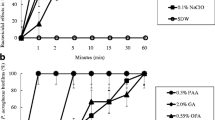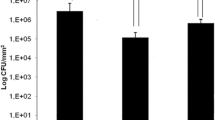Abstract
Objective
Our aim was to assess the anti-biofilm ability of previously unverified individual D-amino acids (DAAs), to produce plasma polymer encapsulated DAAs (PPEDAAs), to measure the shell thickness and subsequent release of DAAs, and to assess the effects of PPEDAAs on Enterococcus faecalis biofilms.
Materials and methods
Microtitre tray assays were used to evaluate the effect of individual DAAs (D-leucine, D-methionine, D-tryptophan, and D-tyrosine) on E. faecalis biofilms of different maturity. A mixture and individual DAAs were encapsulated with a plasma polymer for 10, 20, 40, and 60 min. The shell thickness of PPEDAAs was analyzed by ultra-high-resolution scanning electron microscopy. The release of DAAs from the PPEDAAs encapsulated for 60 min was measured over 7 days using high-performance liquid chromatography. Static biofilms were used to assess the effect of PPEDAAs on E. faecalis biofilms.
Results
Individual DAAs reduced biofilm formation to various degrees, according to the DAA and the experimental times. The shell thicknesses of the PPEDAAs ranged between 31 and 76 nm and increased with encapsulation time. Diffusion of DAAs from the PPEDAAs occurred over 60 min for encapsulated D-leucine, D-methionine, and D-tyrosine and up to 7 days for D-tryptophan. PPEDAAs disrupted biofilms at every experimental time.
Conclusions
PPEDAAs of various shell thickness can be produced with the proposed methodology, DAAs are subsequently released, and the anti-biofilm activity remains unaltered.
Clinical relevance
Individual DAAs and PPEDAAs have anti-biofilm ability and can be considered as part of a biological strategy in endodontics.






Similar content being viewed by others
References
Gulabivala K, Ng Y-L (2014) Endodontics. Mosby, St. Louis
Nair PNR (2014) Endodontic biofilm, technology and pulpal regenerative therapy: where do we go from here? Int Endod J. 47:1003–1011. https://doi.org/10.1111/iej.12287
Nair PN (2006) On the causes of persistent apical periodontitis: a review. Int Endod J. 39:249–281. https://doi.org/10.1111/j.1365-2591.2006.01099.x
Ramirez T, Shrestha A, Kishen A (2011) Inflammatory potential of monospecies biofilm matrix components. Int Endod J. 52:1020–1027. https://doi.org/10.1111/iej.13093
Sundqvist G, Figdor D (2003) Life as an endodontic pathogen. Endod Topics 6:3–28. https://doi.org/10.1111/j.1601-1546.2003.00054.x
Swimberghe R, Coenye T, De Moor R, Meire MA (2019) Biofilm model systems for root canal disinfection: a literature review. Int Endod J. 52:604–628. https://doi.org/10.1111/iej.13050
Rosen E, Tsesis I, Elbahary S, Storzi N, Kolodkin-Gal I (2016) Eradication of Enterococcus faecalis biofilms on human dentin. Front Microbiol. 7:2055. https://doi.org/10.3389/fmicb.2016.02055
Zilm PS, Butnejski V, Rossi-Fedele G, Kidd SP, Edwards S, Vasilev K (2017) D-amino acids reduce Enterococcus faecalis biofilms in-vitro and in the presence of antimicrobials used for root canal treatment. PLoS One. 12:e0170670. https://doi.org/10.1371/journal.pone.0170670
Kolodkin-Gal I, Romero D, Cao S, Clardi J, Kolter R, Loscik R (2010) D-Amino acids trigger biofilm disassembly. Science. 328:627–629. https://doi.org/10.1126/science.1188628
Leiman S, May JM, Lebar M, Kahne D, Kolter R, Losick RD (2013) D-amino acids indirectly inhibit biofilm formation in Bacillus subtilis by interfering with protein synthesis. J Bacteriol 195:5391–5395. https://doi.org/10.1128/mBio.00623-19
Lam H, Oh D-C, Cava F, Takacs CN, Clardy J, de Pedro MA, Waldor MK (2009) D-amino acids govern stationary phase cell wall remodeling in bacteria. Science. 325:1552–1555. https://doi.org/10.1126/science.1178123
Hochbaum AI, Kolodkin-Gal I, Foulston L, Kolter R, Aizenberg J, Losick R (2011) Inhibitory effects of d-amino acids on staphylococcus aureus biofilm development. J Bacteriol. 193:5616–5622. https://doi.org/10.1128/JB.05534-11
Cavallaro A, Vasilev K (2015) Controlled and sustained release of pharmaceuticals via single step solvent-free encapsulation. Chem Comm (Camb). 51:1838–1841. https://doi.org/10.1128/JB.00975-13
Papa J, Cain C, Messer HH (1994) Moisture content of vital vs endodontically treated teeth. Endod Dent Traumatol. 10:91–93. https://doi.org/10.1111/j.1600-9657.1994.tb00067.x
Rossi-Fedele G, Doğramacı EJ, Steier L, de Figueiredo JA (2013) Interaction between chlorhexidine-impregnated gutta-percha points and several chlorine-containing endodontic irrigating solutions. Int Endod J. 46:675–680. https://doi.org/10.1111/iej.12044
Yoo A, Rossi-Fedele G, Kidd SP, Rogers AH, Zilm PS (2018) Association between extracellular material and biofilm formation in response to sodium hypochlorite by clinical isolates of Enterococcus faecalis. J Endod. 44:269–273. https://doi.org/10.1016/j.joen.2017.08.025
Wilson CE, Cathro PC, Rogers AH, Briggs N, Zilm PS (2015) Clonal diversity in biofilm formation by E. faecalis in response to environmental stress associated with endodontic irrigants and medicaments. Int Endod J. 48:210–219. https://doi.org/10.1111/iej.12301
Wang Z, Shen Y, Haapasalo M (2012) Effectiveness of endodontic disinfecting solutions against young and old Enterococcus faecalis biofilms in dentin canals. J Endod. 38:1376–1379. https://doi.org/10.1016/j.joen.2012.06.035
Donlan RM (2001) Biofilm formation: a clinically relevant microbiological process. Clin Infect Dis. 15:1387–1392. https://doi.org/10.1086/322972
Rossi-Fedele G, Roberts AP (2007) A preliminary study investigating the survival of tetracycline resistant Enterococcus faecalis after root canal irrigation with high concentrations of tetracycline. Int Endod J. 40:772–777. https://doi.org/10.1111/j.1365-2591.2007.01285.x
Ali AAA, Cheung BPK, Yau JYY, Matinlinna J, Levesque CM, Belibasakis GN, Neelakantan P (2020) The influence of substrate surface conditioning and biofilm age on the composition of Enterococcus faecalis biofilms. Int Endod J. 53:53–61. https://doi.org/10.1111/iej.13202
Dashper SG, Catmull DV, Liu S-W, Myroforidis H, Zalizniak I, Palamara JE, Huq NL, Reynolds EC (2016) Casein phosphopeptide-amorphous calcium phosphate reduces Streptococcus mutans biofilm development on glass ionomer cement and disrupts established biofilms. PLoS One 11:e0162322. https://doi.org/10.1371/journal.pone.0162322
Chan W, Chowdhury NR, Sharma G, Zilm P, Rossi-Fedele G (2020) Comparison of the biocidal efficacy of sodium dichloroisocyanurate and calcium hydroxide as intracanal medicaments over a 7-day contact time: an ex vivo study. J Endod 46:1273–1278. https://doi.org/10.1016/j.joen.2020.05.011
Watter C, Fleming D, Bishop D, Rumpbaugh KP (2016) Host responses to biofilm. Prog Mol Biol Transl Sci. 142:193–239. https://doi.org/10.1016/bs.pmbts.2016.05.007
Funding
The authors acknowledge the funding for this project from the Australian Dental Research Foundation and the Australian Society of Endodontology.
Author information
Authors and Affiliations
Corresponding author
Ethics declarations
Conflict of interest
The authors declare that they have no conflict of interest.
Ethical approval
For this type of study, ethical approval is not required.
Informed consent
For this type of study, formal consent is not required.
Additional information
Publisher’s note
Springer Nature remains neutral with regard to jurisdictional claims in published maps and institutional affiliations.
Rights and permissions
About this article
Cite this article
Khider, D., Rossi-Fedele, G., Fitzsimmons, T. et al. Disruption of Enterococcus Faecalis biofilms using individual and plasma polymer encapsulated D-amino acids. Clin Oral Invest 25, 3305–3313 (2021). https://doi.org/10.1007/s00784-020-03663-0
Received:
Accepted:
Published:
Issue Date:
DOI: https://doi.org/10.1007/s00784-020-03663-0




